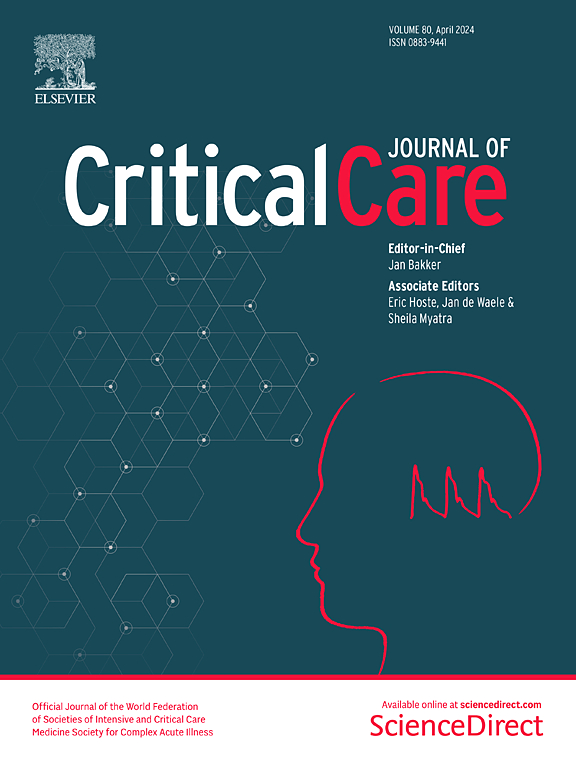Severe listeriosis in intensive care units: insights from a retrospective multicentric study
IF 8.8
1区 医学
Q1 CRITICAL CARE MEDICINE
引用次数: 0
Abstract
Listeriosis is a rare but severe foodborne infection, particularly affecting immunocompromised individuals and older adults. Severe cases may lead to neurolisteriosis and sepsis, necessitating intensive care unit (ICU) admission. This study aims to analyze the demographic characteristics, clinical presentation, microbiological findings, treatments, and outcomes of critically ill patients with Listeria infections in the ICU. A retrospective multicenter study was conducted across 23 French hospitals over a 10-year period, including ICU patients with culture-confirmed Listeria monocytogenes infections. Data on demographics, comorbidities, ICU admission characteristics, biological and microbiological parameters, treatments, and outcomes were collected. The primary outcome was ICU mortality. A multivariable logistic regression model was used to identify factors associated with mortality in patients with neurological manifestations. A total of 110 patients were included, with a median age of 68 years; 61% were male, and 71% were immunocompromised. Neurological involvement was present in most cases. Invasive mechanical ventilation was required in 58% of patients, and vasopressor support in 44%. ICU and in-hospital mortality rates were 25% and 32%, respectively. Among patients with neurolisteriosis, each 1-point decrease in Glasgow Coma Scale score at admission was associated with increased mortality (OR, 1.22; 95% CI 1.05–1.45; p = 0.009), as were higher cerebrospinal fluid (CSF) protein levels (OR, 1.56; 95% CI 1.15–2.41; p = 0.028). Steroid use was not significantly associated with reduced mortality (OR, 0.30; 95% CI 0.07–1.05; p = 0.076). Listeriosis requiring ICU admission is associated with high morbidity and mortality, particularly in older and immunocompromised patients. The severity of these infections is reflected by the frequent need for organ support. Further research is needed to clarify the potential role of steroids in neurolisteriosis.重症监护病房的严重李斯特菌病:来自回顾性多中心研究的见解
李斯特菌病是一种罕见但严重的食源性感染,尤其影响免疫功能低下的个体和老年人。严重者可能导致神经李斯特菌病和败血症,需要进入重症监护病房(ICU)。本研究旨在分析ICU重症李斯特菌感染患者的人口学特征、临床表现、微生物学发现、治疗和结局。一项回顾性多中心研究在法国23家医院进行,为期10年,包括ICU患者培养证实单核细胞增生李斯特菌感染。收集了人口统计学、合并症、ICU入院特征、生物学和微生物学参数、治疗和结局的数据。主要终点是ICU死亡率。采用多变量logistic回归模型确定与神经症状患者死亡率相关的因素。共纳入110例患者,中位年龄为68岁;61%为男性,71%为免疫功能低下。大多数病例存在神经系统受累。58%的患者需要有创机械通气,44%的患者需要血管加压剂支持。ICU和住院死亡率分别为25%和32%。在神经李斯特菌病患者中,入院时格拉斯哥昏迷评分每降低1分与死亡率增加相关(OR, 1.22;95% ci 1.05-1.45;p = 0.009),脑脊液(CSF)蛋白水平升高(OR, 1.56;95% ci 1.15-2.41;p = 0.028)。使用类固醇与降低死亡率没有显著相关性(OR, 0.30;95% ci 0.07-1.05;p = 0.076)。需要入住ICU的李斯特菌病与高发病率和死亡率相关,特别是在老年和免疫功能低下的患者中。这些感染的严重程度反映在经常需要器官支持上。需要进一步的研究来阐明类固醇在神经李斯特菌病中的潜在作用。
本文章由计算机程序翻译,如有差异,请以英文原文为准。
求助全文
约1分钟内获得全文
求助全文
来源期刊

Critical Care
医学-危重病医学
CiteScore
20.60
自引率
3.30%
发文量
348
审稿时长
1.5 months
期刊介绍:
Critical Care is an esteemed international medical journal that undergoes a rigorous peer-review process to maintain its high quality standards. Its primary objective is to enhance the healthcare services offered to critically ill patients. To achieve this, the journal focuses on gathering, exchanging, disseminating, and endorsing evidence-based information that is highly relevant to intensivists. By doing so, Critical Care seeks to provide a thorough and inclusive examination of the intensive care field.
 求助内容:
求助内容: 应助结果提醒方式:
应助结果提醒方式:


